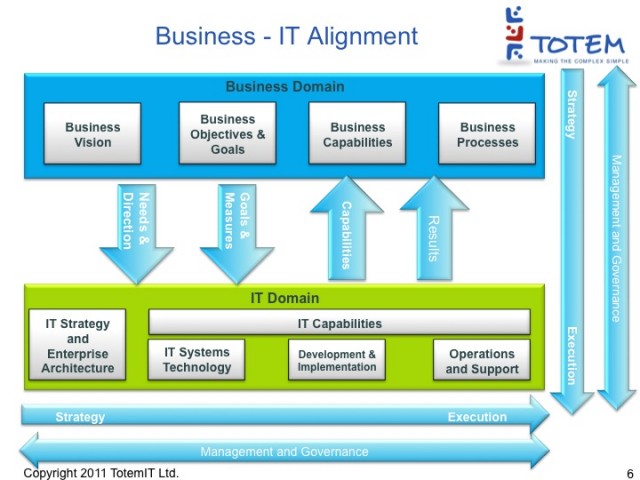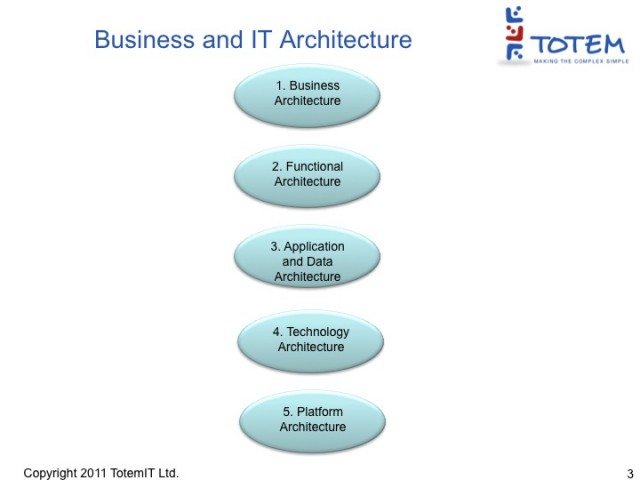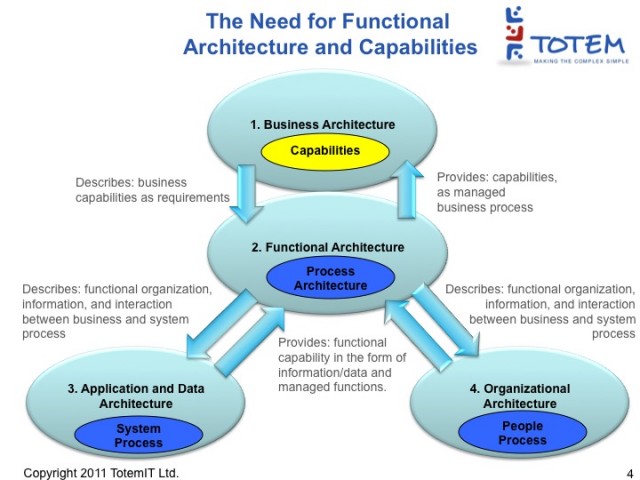Benefits of implementation of a business architecture will be seen in:
- Governance
- Communications
- Process optimisation
- System re-use
- Financial and management control
- Risk management
- Quality
- Flexibility and speed of change
- Engagement of staff
- Performance management

1. Some quick definitions
The bridge between business and IT is the functional architecture.

Business Architecture defines the business strategy, governance, organization, and key business processes. The business architecture will include other architectural domains such as brand, product, and process architecture.
Functional Architecture describes the organization of the key functions required to perform the capabilities described by the business architecture. The key purpose for functional architecture is to create a clear understanding of the responsibilities to be assigned by each function.
Functional architecture commonly consists of both business and IT views.
- The business view describes how the business organization, function and processes are organized to provide the capabilities required by the business.
- The IT view describes how IT functionality is organized to provide the capabilities and support the business processes.
Application Architecture defines the functional capabilities provided by applications. Applications are logical groupings of functionality appropriate for the organization. It also provides a blueprint for the individual application systems to be deployed, their interactions, and their relationships to the core business processes of the organization.
E.g. a rating application within the billing domain will be given the responsibility to perform a set of functions for the organization. This may be a subset of the total functionality required to perform rating. Other systems or processes could provide other functionality.
Data Architecture describes the structure of an organization’s logical and physical data assets and data management resources.
Technology Architecture describes the logical software and hardware capabilities that are required to support the deployment of business, data, and application services.
Platform Architecture describes the operating systems, hardware and includes IT infrastructure, middleware, networks, and communications.
2. Business Capability and IT Architecture Alignment
One of the core concepts of business architecture is capability.
Definition: Capability is the quality of being capable; to have the capacity or ability to do something, achieve specific effects or declared goals and objectives. Enterprises in essence consist of a portfolio or matrix of capabilities that are used in various combinations to achieve outcomes. Within that portfolio, a capability will be transient unless managed and maintained over time. Therefore, a typical capability lifecycle spans needs, requirements, acquisition, in-service and obsolescence/disposal phases. (Wikipedia)
The functional architecture is used to ensure that the business capabilities expressed as requirements are expanded into the set of more granular functions required to provide the capability. This allows a quick functional gap analysis to be performed followed by high level benefit analysis and creation of roadmaps allowing IT and the business to plan effectively.

In many organizations there has been a historical tendency to focus on technology rather than the need for functional architecture. However this layer creates the bridge between the business and IT by providing a common language, definitions and boundaries that allow business and IT to become aligned.
By creating a common understanding and language for capability and function the business and IT domains can communicate more efficiently and achieve huge benefits.